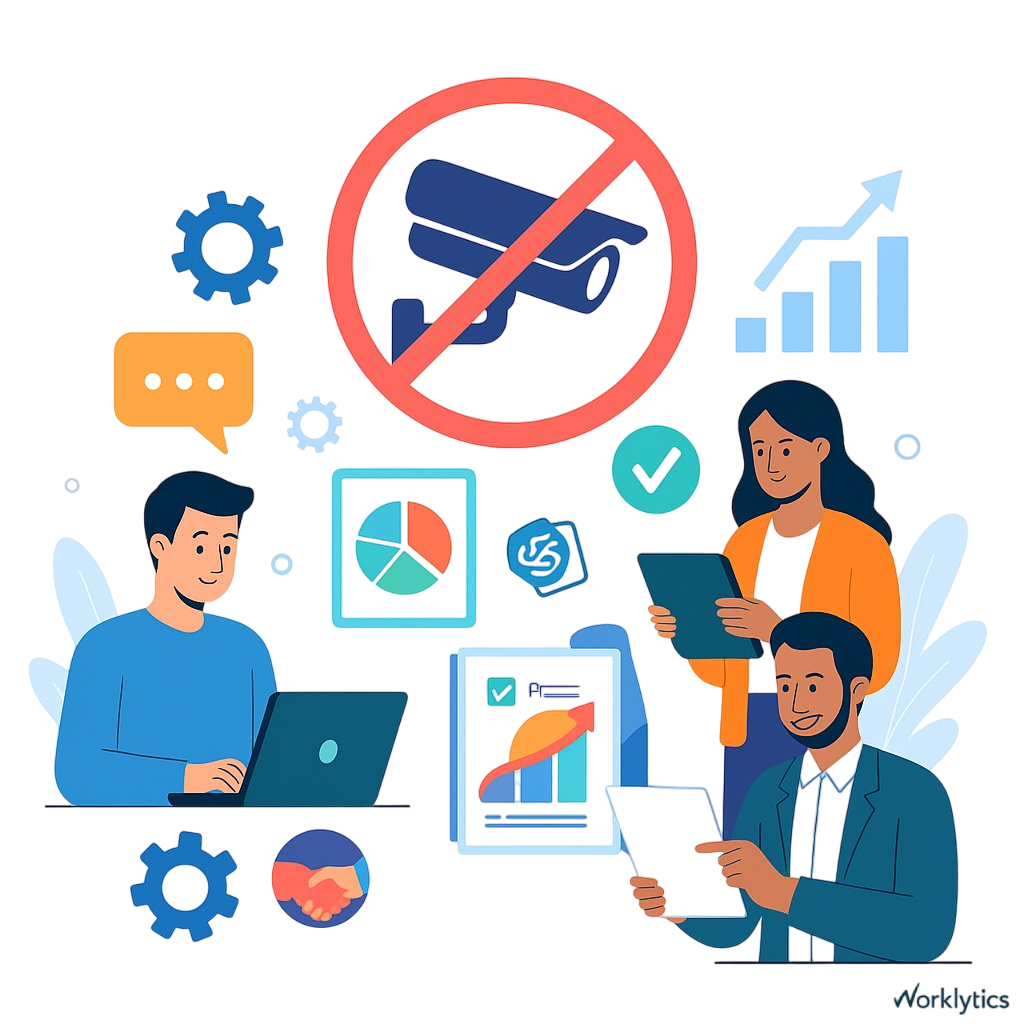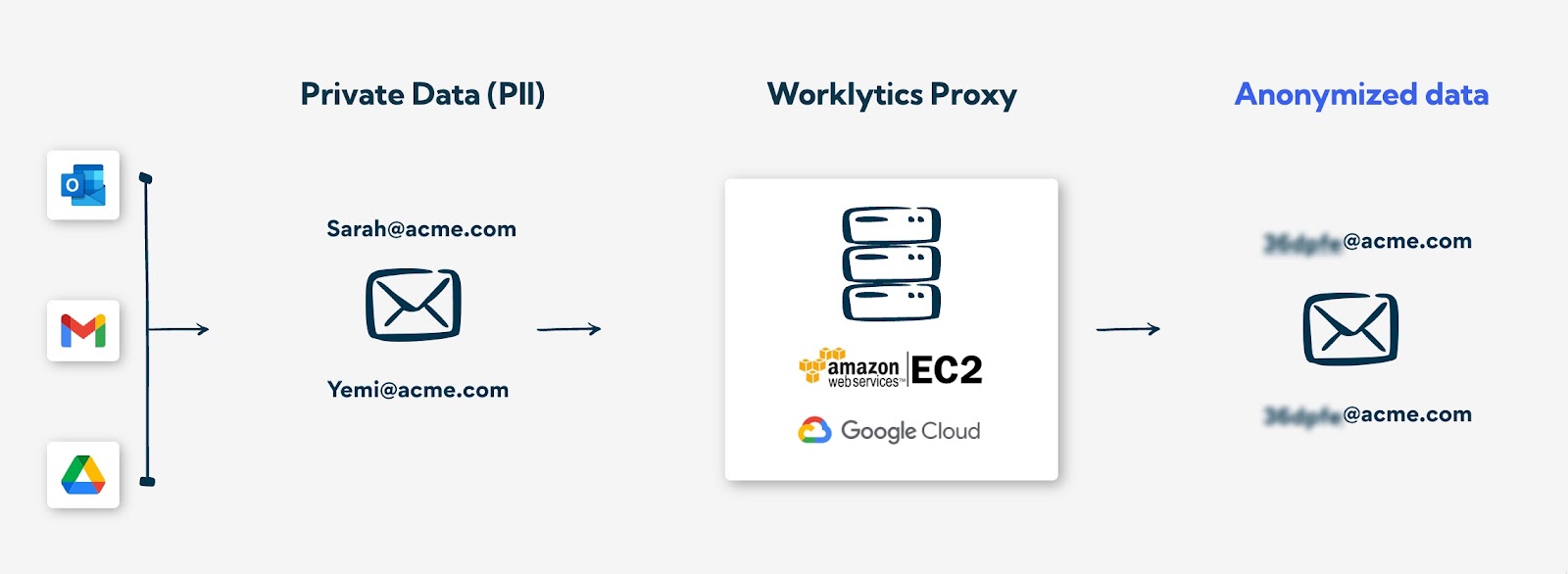
Employee monitoring has become a common trend in modern workplaces, often justified as a means to boost employee productivity and ensure accountability. However, the reliance on employee monitoring systems raises significant concerns regarding employee trust, engagement, and workplace culture.
One major disadvantage is that organizations attempting to track employee productivity may be doing more harm than good. In this article, we will explore the negative effects of monitoring employees and provide key reasons why companies should reconsider their approach. In particular why they should avoid invasive productivity tracking and tools designed to monitor employee activity.
Employee monitoring or employee surveillance software comprises a broad set of invasive tools designed to monitor user activity. They include tools that monitor mouse movement and keystroke tracking to provide employers with insights into user activity on their computers.
These tools can also track websites visited by employees, providing insights into their online activities, such as whether they are checking social media platforms like Facebook or searching for job opportunities on LinkedIn.
Most employee surveillance tools include a range of tracking functions designed to monitor nearly every digital move an employee makes:
While such tools can yield data that ostensibly reflect employee engagement, they often focus on superficial metrics that do not accurately represent the quality or output of work performed.
Moreover, the invasive nature of mouse and keystroke monitoring can lead to feelings of mistrust among employees, raising ethical concerns about privacy and autonomy, which can ultimately harm workplace morale and culture.
Relying on user activity monitoring as a measure of productivity is fundamentally flawed. Monitoring systems focused on tracking employee performance often fail to capture the true quality and value of work produced. While productivity tracking tools like productivity dashboards may offer superficial insights, these metrics do not necessarily correlate with actual outcomes.
Employees may engage in tasks that lead to minimal results while others achieve high-quality work in less time. Relying only on tracking employees’ activities can mislead management and neglect the creative thinking that ultimately contributes to a company's success.
One of the immediate consequences of using remote employee monitoring software is the erosion of trust between management and staff. When employees know that their activities are being monitored through computer surveillance or user tracking software, it fosters a culture of suspicion. Such an environment leads to disengagement, as employees may feel they are under constant scrutiny and are not trusted to manage their own time and workloads effectively.
Employees thrive in environments that promote autonomy and independence. Monitoring practices, especially those focused on tracking employee productivity using employee monitoring software, can undermine this autonomy. Constant oversight through employee tracking can lead to reduced engagement levels. Employees are likely to refrain from starting new projects or expressing creative ideas, which stifles motivation and overall morale.
This environment can lead to reduced engagement levels, where employees operate in “safe mode,” doing only what’s necessary to meet monitored benchmarks. Over time, this diminishes creative problem-solving, initiative, and willingness to collaborate—all of which are critical for organizational growth.
The use of employee productivity monitoring software raises significant legal and ethical concerns. Privacy laws vary by jurisdiction, and companies using worker monitoring techniques could find themselves in legal difficulties if they fail to comply with these regulations. Country specific legislation such as GDPR and CCPA contains specific language designed to protect employees from invasive forms of monitoring.
In addition, there are ethical questions regarding the extent to which employers should intrude into their employees' personal and professional lives. Companies must balance managing employee performance with respecting individual privacy.
Implementing employee monitoring tools can dramatically alter a company's culture, transforming it into a hostile environment. Monitoring practices, particularly those involving employee productivity tracking through monitoring software, can erode these benefits if not implemented thoughtfully. While intended to improve efficiency or maintain accountability, constant oversight often shifts workplace dynamics from one of trust to one of surveillance. This can create unintended negative effects, such as:
Over time, these impacts can lead to a transactional work culture where employees prioritize meeting measurable targets over delivering innovative, high-quality contributions. The result is an environment where creativity is stifled, collaboration becomes cautious, and team energy wanes.
Ironically, while companies often implement productivity tracking software to boost output, it can have the opposite effect. Constant monitoring changes the nature of work by replacing a culture of trust with one of control. When employees feel every action is being scrutinized, their sense of autonomy diminishes, and with it, their intrinsic motivation.
Instead of concentrating on meaningful, high-quality contributions, employees may shift their energy toward simply meeting tracked metrics or appearing busy. This reactive mindset can reduce creativity, slow problem-solving, and discourage initiative. Over time, the stress of being under continuous observation can create mental fatigue and heighten anxiety, leading to burnout. The cumulative effect is lower engagement, less innovation, and ultimately, a decline in overall productivity—the very outcome the monitoring was meant to prevent.
High employee turnover rates often signal deeper issues within a company. Implementing employee activity tracking systems can exacerbate this problem. When employees feel undervalued and constantly surveilled through monitoring employees, they are more likely to seek employment opportunities elsewhere. The organization then faces significant costs associated with recruiting and training new hires, further detracting from its bottom line.
Employee monitoring can create barriers to open communication. When workers are aware their user activity is under constant scrutiny, they may hesitate to share concerns or ideas. This impaired communication can hinder collaboration within teams. Organizations should prioritize fostering transparent communication channels rather than relying on methods of monitoring.
One significant drawback of relying on activity tracking as a measure of employee productivity is that it is easily gameable. Employees may utilize various tools that fake mouse movement or automate keystrokes to create the illusion of being actively engaged in their work. Some individuals may also fake productive actions, such as repeatedly switching between applications or generating fake reports. This behavior wastes time and can mislead management into believing that productivity levels are high. Organizations may end up with inaccurate performance assessments, leading to misguided decisions and a failure to address the real issues affecting workforce productivity.
Monitoring employees’ social media intrudes on privacy and undermines trust in the workplace. Such practices can damage morale and create a culture of surveillance rather than respect.
While employee monitoring may create short-term productivity gains by pressuring workers, it often backfires by increasing stress and reducing trust. Over time, this can harm engagement and lower overall performance.
No, there are better alternative practices fostering transparency and using productivity analytics tools that focus on collaboration patterns and well-being rather than surveillance.
In today’s increasingly data‑driven workplaces, leveraging Workplace Insights is a far superior solution to traditional employee monitoring systems. Complementing those insights with tools that help control and manage employees access ensures security and least‑privilege practices—without resorting to surveillance. By concentrating on corporate data only and performing analysis at the group level, organizations can gain a holistic view of workflows and processes without encroaching on individual privacy.
Rather than wasting time on activity metrics that may not accurately reflect true productivity, leaders should prioritize identifying and removing barriers and bottlenecks within workflows. Focusing on process improvement and streamlining operations, organizations can empower their teams to work more effectively and efficiently.
Workplace insights provide a comprehensive understanding of team dynamics, allowing managers to see how various tasks are interlinked and to identify areas where improvements can be made. This approach shifts the focus from scrutinizing individual performance metrics, which can be misleading and damaging, to understanding the collective processes that drive productivity.

De-identifying corporate productivity data and aggregating it to the group level is key to protecting employee privacy while still deriving valuable insights. This strategy ensures that individual contributions are not singled out, fostering a culture of trust and openness within the team. With aggregated data, leaders can assess group workflows without making employees feel like they are under constant scrutiny.
By protecting privacy, organizations encourage team members to engage more freely and contribute ideas, knowing that their autonomy is respected. This supportive environment promotes innovation and collaboration, further enhancing overall productivity.
For more information on how to implement workplace analytics while protecting employee privacy refer to our privacy page.
